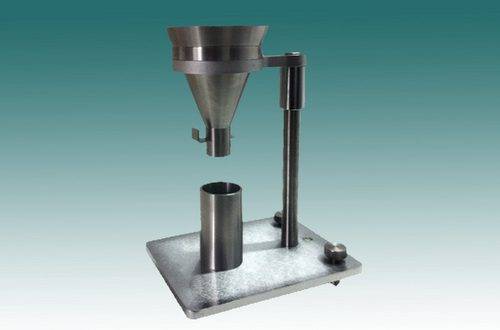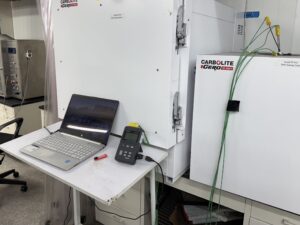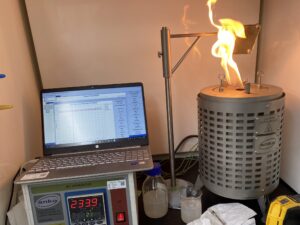We also offer
What is Apparent Bulk Density Test
Apparent bulk density represents the mass of a bulk sample of particulate or powdered material (including void spaces between particles) divided by its total volume. It is expressed in mass per unit volume (e.g., grams per cubic centimeter).
Apparent bulk density is determined by weighing a known volume of material filled in a container or by measuring the volume of the material and then calculating the mass.
Formula:
Apparent Bulk Density = Mass of Material / Volume of Material
Particle size distribution and shape influence bulk density. Irregularly shaped or fine particles tend to have higher bulk density due to closer packing, while larger or spherical particles may have lower bulk density.
Apparent bulk density provides insight into the packing efficiency and flow characteristics of particulate materials. This test is essential in industries such as pharmaceuticals, agriculture, construction, and manufacturing. It is commonly used to assess powdered or granular materials such as powders, grains, pharmaceuticals, minerals, fertilizers, and construction materials.
When to Perform Apparent Bulk Density Test
The apparent bulk density test defines the mass of a bulk material per unit volume, including the intergranular void space. It helps in understanding the packing and flow characteristics of materials like powders, granules, or solid particles.
-
Transportation and Handling: Understanding apparent bulk density is crucial for the safe transport of granular or powdered materials. It helps determine suitable transport vessels, containment systems, and safe loading and unloading procedures.
-
Manufacturing and Processing: In industries such as pharmaceuticals, food, or mining, apparent bulk density helps evaluate material behavior during processing. This is vital for preventing accidents, ensuring equipment safety, and avoiding blockages in machinery.
-
Hazard Prevention: Some powders and granules pose risks during bulk handling. Measuring apparent bulk density aids in identifying hazards such as dust generation, static buildup, or fire and explosion risks, allowing for effective control measures.
Why Choose Prime Process Safety Center
Prime Process Safety Center is a leader in process safety testing, staffed with highly experienced laboratory personnel.
-
We specialize in performing apparent bulk density tests with accuracy and reliability.
-
Our state-of-the-art bulk density testing equipment ensures precise and consistent measurements.
-
We follow strict testing protocols and quality control procedures to deliver dependable data.
- As an ISO/IEC 17025:2017 accredited laboratory, we follow rigorous quality and competency requirements for every test we perform.
-
Our goal is to provide accurate, reliable, and defensible data that meets industry and regulatory standards.
At Prime Process Safety Center, we understand the importance of data quality and work diligently to achieve results that support safe and compliant industrial operations.
FAQ
What is apparent bulk density, and how is it measured?
Apparent bulk density refers to the mass of a bulk material divided by its total volume, including the intergranular void spaces. It's typically measured by filling a container of known volume with the material and calculating the mass of the material in that volume.
Why is apparent bulk density important in safety considerations?
Apparent bulk density is crucial in safety because it influences the handling, storage, transportation, and processing of bulk materials. Understanding this metric helps prevent hazards like dust explosions, facilitates proper storage to avoid collapses or spills, and ensures safe handling and transport procedures.
How does apparent bulk density impact material handling and storage practices?
Apparent bulk density affects how materials pack, flow, and stack. Materials with different densities require varying handling techniques and storage conditions. This metric guides proper stacking to prevent collapses, helps in designing adequate containment systems, and aids in preventing hazards related to poor flow characteristics or instability.
What safety measures are recommended based on apparent bulk density?
Safety measures based on apparent bulk density include controlling dust generation, managing static electricity, implementing proper ventilation systems, using appropriate personal protective equipment (PPE), conducting regular equipment maintenance to prevent blockages, and following safe handling and storage protocols.
In what industries or applications is apparent bulk density particularly important for safety?
Apparent bulk density is crucial in industries dealing with powdered or granular materials, such as pharmaceuticals, food processing, mining, agriculture, and chemical manufacturing. It is relevant in applications involving transportation, storage, processing, and quality control of bulk materials.
















